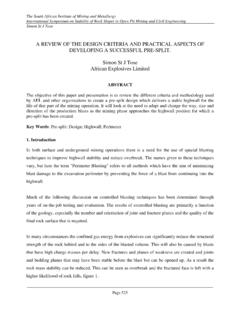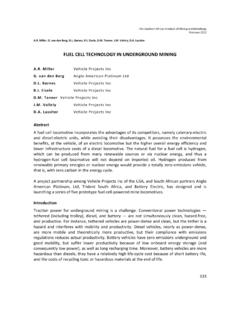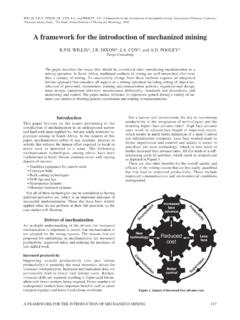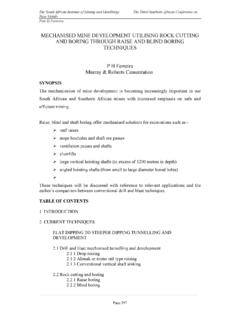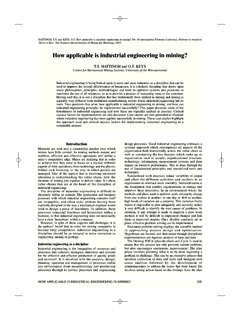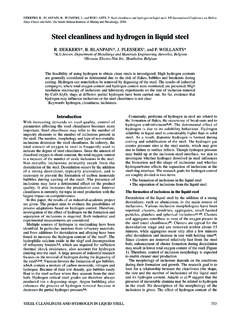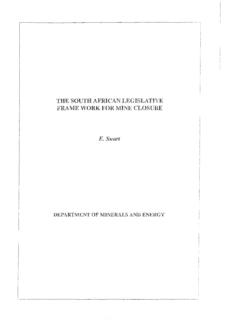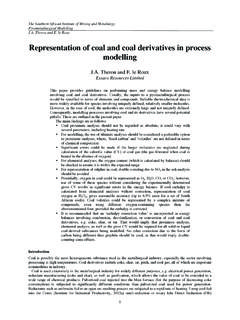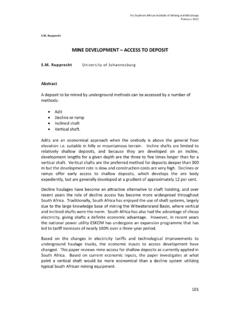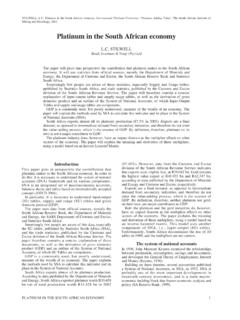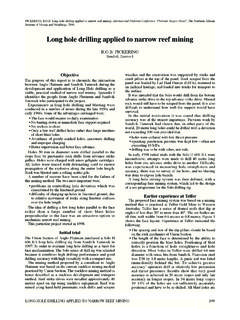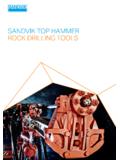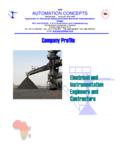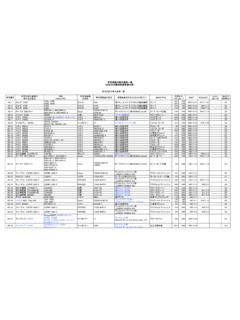Transcription of BLAST FRAGMENTATION OPTIMIZATION AT TARKWA GOLD …
1 The Southern African Institute of mining and Metallurgy Surface mining 2008 Alexandra AmielPage 113 BLAST FRAGMENTATION OPTIMIZATION AT TARKWA gold MINE USING 6 SIGMA METHODOLOGIES Miss Alexandra Amiel Goldfields Ghana Ltd TARKWA gold Mine Abstract: TARKWA gold Mine is owned by gold Fields Ghana, IAMGOLD and the Government of the Republic of Ghana in a 71%, 19% and 10% ratio. The mine is operated by gold Fields Ghana. This large, low-grade, open pit, gold mining operation is located in TARKWA , in the Western Region of Ghana, approximately 320 kilometres by road, west of Accra, the capital of Ghana, West Africa. In the Financial year ended June 2007, the operation mined a total of 108 million tonnes of which 22 million tonnes was ore. The mined ore is processed through three gyratory crushers supplying two heap leach pads (North and South) and a carbon-in-leach (CIL) the 6 Sigma project commenced, the current FRAGMENTATION was resulting in sub-optimal feed size to these crushers.
2 It was decided to use 6 Sigma methodology to improve the FRAGMENTATION . A defect was defined as a FRAGMENTATION analysis indicating less than 95% passing 750mm. The objective was to improve FRAGMENTATION in order to achieve a constant throughput to the north heap leach crusher of 1500 t/hr, a 5% increase in pit loading efficiency and a 50% decrease in rock breaker hours, equipment damage costs and in-pit sheeting costs respectively. However, this was not to be achieved at the expense of grade control as TARKWA is exploiting a low grade, high volume deposit and therefore ore dilution must be kept to a paper is intended to take the reader through the various 6 Sigma phases of the project (Define Measure Analyse Improve Control) which have resulted in a 10% reduction in loading times, of which half has been attributed to improved FRAGMENTATION , as well as a substantial increase in blasted stocks.
3 The focus has been on both drilling and blasting parameters as both processes had to be taken into account. These parameters are technical but personnel factors were also identified and dealt with as they arose. In order to measure the impact of any change in the process parameters on the FRAGMENTATION size distribution, cameras have been acquired. One has been installed looking into the bowl of the north crusher and the other one was dedicated to field observation, of individual blasts. Both are used for on-going FRAGMENTATION analysis. At TARKWA , mining efficiency is strongly dependent on good FRAGMENTATION as well as the presence of un-blasted toes on the pit floors. Crusher throughput depends on an The Southern African Institute of mining and Metallurgy Surface mining 2008 Alexandra AmielPage 114 acceptable ore fragment size.
4 Compliance to plan with regards to actual hole depths was temporarily monitored by manual hole dipping, but, this is now being replaced with a fully automated Drill Data Management system developed by Sandvik and Modular Six Sigma methodologies, using control charts based on data collected in the field, allowed the mine to improve methods with regards to the control of blasted material. It also enforced the implementation of a quality control programme encompassing the entire Drill and BLAST process. 1. Introduction The primary objectives of the optimisation are to maximise crusher throughput and minimise loading times. The greatest influence on both can be realised through improved FRAGMENTATION of the blasted ore and waste within the pit. The measure of the effect of the size distribution of the blasted material was done via: Analysis of pictures taken in the pit, after the BLAST , or from a camera newly installed facing the bowl of the north crusher.
5 This was done with software acquired from Split Engineering Monitoring of the rock breaker hours Continuous monitoring of loading times for all the mine s excavators After the first phases of the 6 Sigma methodology, Define Measure Analyse, the Improve phase will introduce new procedures and their effect will be evaluated by monitoring the effects of such changes in blasting and mining parameters that affect TARKWA gold Mine Location and history TARKWA gold Mine is located in Southern Ghana, approximately 320 kilometres by road, west of Accra, capital of Ghana. It is an open pit gold mining operation situated 5 north and 2 west. The current mining area is 56 square Southern African Institute of mining and Metallurgy Surface mining 2008 Alexandra AmielPage 115 Figure 1: Map of Africa and Ghana. Location of TARKWA The summary of the mining history given hereunder is based on the work of (Griffis, et al.)
6 2002), Brown (2000), Smith (1996), Spathelf (2002), Karpeta (2002) and the unpublished reports of Cole (2004 Abosso Deeps review of previous work) and Morcombe (2005). Records of The Ghana Chamber of Mines have also been used. Small-scale gold mining activities are thought to have taken place in the TARKWA district for several centuries. In 1877, rumours of extensive artisanal workings led Marie-Joseph Bonnat to investigate the Taquah area, where he subsequently acquired a 40-year mining lease in 1878. In 1888, the concession passed into the hands of the British registered TARKWA and Abosso gold mining Company. The company was reconstructed twice, once the following year and again in company known as Taquah and Abosso Mines Limited came into existence in 1927 as a result of the reconstruction and amalgamation process, including the, Abosso, Adja Bippo and Cinnamon Bippo Mines and the Taquah Mine located within the TARKWA town itself.
7 Amalgamated Banket Areas was registered in 1935 comprising of the Abontiakoon and Taquah properties. This was followed by the opening up and development of the Mantraim, Pepe and Akontansi properties. In 1961 the State gold mining Company was registered and this organisation took over operations. Amalgamated Banket Areas was later incorporated in to TARKWA Goldfields in late 1972. In 1992 the State gold mining Company invited gold Fields to perform due diligences of both Prestea Goldfields and TARKWA Goldfields and gold Fields took over operations at TARKWA in July 1993. Surface mining operations commenced in 1997 and underground operations were discontinued in 1999 once the ore in the underground syncline was exhausted. The Southern African Institute of mining and Metallurgy Surface mining 2008 Alexandra AmielPage 116 Geology The TARKWA orebody is a paleoplacer deposit.
8 The reefs are a part of the Banket formation which consists of several conglomerate horizons separated by barren can be subdivided laterally and vertically. Lateral subdivisions identify channel deep, channel flank and interchannel environments, each of which has a characteristic gold content, channel flank being the highest. Vertical subdivisions differentiate Time Units (T1 to T4) each of which has a different origin and gold content, T3 being generally the highest. These lateral and vertical subdivisions can be identified in core and in the pits. Their identification facilitates the selection of homogeneous domains. Due to the alternance of reef / waste layers within the orebody, selective mining is practiced at TARKWA . This allows the mine to achieve planned grades by separating the ore from waste in a way that minimises dilution and minimises ore loss. mining The Load & Haul and Drill rig fleets at the time of the project consisted of following: Liebherr 984 Excavators 4 Liebherr 994_200 Excavators 4 Liebherr 994B Excavators 2 Liebherr 994B Face Shovel 1 O&K RH120 Excavator 1 Caterpillar 785C Trucks 36 Tamrock Pantera 1500 Drill Rigs 20 As from July 2008, the fleets will be increased by 3 excavators, 8 trucks and 2 drill rigs.
9 Truck allocation (dispatching) is performed by Modular mining s Intellimine Dispatch Fleet Management System. Currently, TARKWA gold Mine produces an average total of 9 million tons of broken rock per month. Of this total, million tons are waste stripping and the remaining million tons are gold bearing ore, which is recovered by means of selective the million tons of ore, million tons are directed to the two Heap Leach (HL) plants at an average grade of g/t, and 485 000 tons are directed to the Carbon in Leach (CIL) plant at about g/t, for gold recovery. The Southern African Institute of mining and Metallurgy Surface mining 2008 Alexandra AmielPage 117 Processing Currently, an average of million tons of Heap Leach ore and 410,000 tons of CIL/Mill ore is crushed on a monthly basis. Primary crushing reduces the bulk ore to a fragment size of about 100 mm, from where the CIL material goes straight to the HL material goes through secondary and tertiary crushers to reduce the fragment size to an average of 8 to 12 mm, before it gets routed on a series of conveyors to the agglomeration plants.
10 Heap Leach The crushed ore is conveyed to the agglomeration plant, where it is mixed with about 5kg s of cement for every ton of agglomerated ore now follows a conveyed route to the leach pads where it is routed to the top of the pads by a series of step - like conveyors. The leach pads are equipped with an integrated irrigation system, which sprays cyanide onto the pads. The cyanide filters down through the porous gold bearing ore and absorbs the gold to produce a pregnant solution. The pregnant solution is contained at the base of the pads and then routed along a series of channels and drainage pipes to the respective ADR plants. During the final recovery process, the gold in the pregnant solution is adsorbed onto activated carbon. It is then stripped from the carbon with a caustic soda/cyanide solution at elevated temperatures and then precipitated out of this solution by using zinc.
